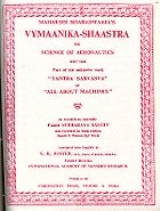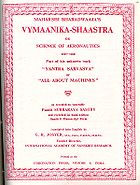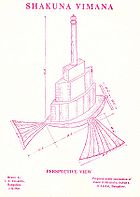
Vaimanika Shastra
Encyclopedia

Sanskrit
Sanskrit , is a historical Indo-Aryan language and the primary liturgical language of Hinduism, Jainism and Buddhism.Buddhism: besides Pali, see Buddhist Hybrid Sanskrit Today, it is listed as one of the 22 scheduled languages of India and is an official language of the state of Uttarakhand...
text on aeronautics obtained by psychic channeling
Mediumship
Mediumship is described as a form of communication with spirits. It is a practice in religious beliefs such as Spiritualism, Spiritism, Espiritismo, Candomblé, Voodoo and Umbanda.- Concept :...
and automatic writing
Automatic writing
Automatic writing or psychography is writing which the writer states to be produced from a subconscious and/or spiritual source without conscious awareness of the content.-History:...
. It makes the claim that the vimāna
Vimana
Vimāna is a word with several meanings ranging from temple or palace to mythological flying machines described in Sanskrit epics.-Etymology and usage:Sanskrit vi-māna literally means "measuring out, traversing" or "having been measured out"...
s mentioned in ancient Sanskrit epics were advanced aerodynamic flying vehicles, similar to a rocket
Rocket
A rocket is a missile, spacecraft, aircraft or other vehicle which obtains thrust from a rocket engine. In all rockets, the exhaust is formed entirely from propellants carried within the rocket before use. Rocket engines work by action and reaction...
.
The existence of the text was revealed in 1952 by G. R. Josyer who asserted that it was written by Pandit Subbaraya Shastry (1866–1940), who dictated it during the years 1918–1923. A Hindi translation was published in 1959, while the Sanskrit text with an English translation was published in 1973. It contains 3000 shloka
Shloka
A ' is a category of verse line developed from the Vedic Anuṣṭubh. It is the basis for Indian Epic verse, and may be considered the Indian verse form par excellence, occurring, as it does, far more frequently than any other meter in classical Sanskrit poetry. The Mahabharata and Ramayana, for...
s in 8 chapters which Shastry claimed was psychically delivered to him by the ancient Hindu sage
Maharishi
Maharishi is the anglicized version of the Sanskrit word Maharshi महर्षि . Maharishi is often use as an addition to a person's name as an honorary title. The term was first seen in modern English literature in the 18th century...
Bharadvaja,. The text has gained favor among proponents of ancient astronaut theories.
A study by aeronautical and mechanical engineering at Indian Institute of Science, Bangalore in 1974 concluded that the aircraft described in the text were "poor concoctions" and that the author showed a complete lack of understanding of aeronautics. The study also states "The Rukma Vimana was the only one which made sense. It had long vertical ducts with fans on the top to suck air from the top and send it down the ducts, generating a lift in the process."
Origin and publication
Subbaraya Shastry was a mystic from AnekalAnekal
Anekal is a taluk of Bangalore district. It lies in the southern part of the Bangalore metropolitan area around 40 kilometres from downtown Bangalore.Kannada is the most widely spoken languages in Anekal.Anekal is known for the karaga festivals...
, who was reputed to speak out verses (sloka
Sloka
Sloka may refer to:* Sloka, Latvia, a neighbourhood of Jūrmala, Latvia* Sloka meter, a Sanskrit meter* Śloka, a Hindu prayer* Sloka Gora, a small settlement in central Slovenia* Sloka...
s) whenever he got inspiration, described by Josyer as "a walking lexicon gifted with occult perception". According to Josyer, he dictated the text to G. Venkatachala Sharma in the early 1900s (completing it in 1923).
Subbaraya Shastry died in 1941, and Venkatachala took his manuscripts into keeping. The Vaimanika Shastra manuscript appeared at Rajakiya Sanskrit Library, Baroda by 1944.
The text was published in Hindi
Hindi
Standard Hindi, or more precisely Modern Standard Hindi, also known as Manak Hindi , High Hindi, Nagari Hindi, and Literary Hindi, is a standardized and sanskritized register of the Hindustani language derived from the Khariboli dialect of Delhi...
in 1959 and later in English by G.R. Josyer, titled Vymanika Shastra. Josyer's edition, also added illustrations drawn by T. K. Ellappa, a draughtsman at a local engineering college in Bangalore
Bangalore
Bengaluru , formerly called Bengaluru is the capital of the Indian state of Karnataka. Bangalore is nicknamed the Garden City and was once called a pensioner's paradise. Located on the Deccan Plateau in the south-eastern part of Karnataka, Bangalore is India's third most populous city and...
, under the direction of Shastry, which had been missed in the 1959 edition.
Its existence was first announced publicly in a 1952 press release by G.R. Josyer, who had founded his "International Academy of Sanskrit Research" in Mysore the year before. In the foreword to the 1973 publication that contained the full Sanskrit text with English translation, Josyer quotes a 1952 press release of his which was "published in all the leading dailies of India, and was taken up by Reuter and other World Press News Services":
Mr. G. R. Josyer, Director of the International Academy of Sanskrit Research in Mysore, in the course of an interview recently, showed some very ancient manuscripts which the Academy had collected. He claimed that the manuscripts were several thousands of years old, compiled by ancient rishis, Bharadwaja, Narada and others, dealing, not with the mysticism of ancient Hindu philosophy of Atman or Brahman, but with more mundane things vital for the existence of man and progress of nations both in times of peace and war.
[...] One manuscript dealt with Aeronautics, construction of various types of aircraft for civil aviation and for warfare. [...] Mr. Josyer showed some types of designs and drawing of a helicopter-type cargo-loading plane, specially meant for carrying combustibles and ammunition, passenger aircraft carrying 400 to 500 persons, double and treble-decked aircraft. Each of these types had been fully described.
Josyer then tells how he was visited by "Miss Jean Lyon, journalist of Toronto and New York" for an interview, and how Lyon in her Just Half a World Away (1954) concluded that he was "guilty of a rabid nationalism, seeking to wipe out everything since the Vedas".
A critical review pronounced Josyer's introduction to be "least scholarly by any standards." and said that "the people connected with publication – directly or indirectly – are solely to blame either for distorting or hiding the history of the manuscripts." perhaps in an attempt to "eulogise and glorify whatever they can find about our past, even without valid evidence". By tracing the provenance of the manuscript, interviewing associates of S. Shastry (including G. V. Sharma to whom the text was originally dictated), and based on the linguistic analysis of the text, the review concluded that it came into existence sometime between 1900 and 1922.
Structure and content

In 1991, the English portion and the illustrations from the Josyer book were reprinted by David Hatcher Childress
David Hatcher Childress
David Hatcher Childress is an American author and publisher of books on topics on alternative history and historical revisionism. His works cover such subjects as pre-Columbian trans-oceanic contact, Atlantis, Lemuria, Ancient Astronauts, UFOs, Nikola Tesla, the Knights Templar, lost cities and...
in Vimana Aircraft of Ancient India & Atlantis as part of the Lost Science Series. According to Childress, the 8 chapters treat the following:
- The secrets of constructing aeroplanes, which will not break, which cannot be cut, will not catch fire, and cannot be destroyed.
- The secret of making planes motionless.
- The secret of making planes invisible.
- The secret of hearing conversations and other sounds in enemy places.
- The secret of retrieving photographs of the interior of enemy planes
- The secret of ascertaining the direction of enemy planes approach.
- The secret of making persons in enemy planes lose consciousness.
- The secret of destroying enemy planes.
The propulsion of the Vimanas according to Kanjilal (1985) is by a "Mercury Vortex Engines", apparently a concept similar to electric propulsion
Electric propulsion
An electrically powered spacecraft propulsion system is any of a number of forms of electric motors which spacecraft can employ to gain mechanical energy in outer space...
. Childress finds evidence for this "mercury vortex engine" in the Samarangana Sutradhara, an 11th century treatise on architecture.
J. B. Hare of the Internet Sacred Text Archive
Internet Sacred Text Archive
The Internet Sacred Text Archive is a website dedicated to the preservation of electronic public domain texts, specifically those with significant cultural value...
in 2005 compiled an online edition of Josyer's 1973 book, in the site's "UFOs" section. In his introduction, Hare writes
The Vymanika Shastra was first committed to writing between 1918 and 1923, and nobody is claiming that it came from some mysterious antique manuscript. The fact is, there are no manuscripts of this text prior to 1918, and nobody is claiming that there are. So on one level, this is not a hoaxHoaxA hoax is a deliberately fabricated falsehood made to masquerade as truth. It is distinguishable from errors in observation or judgment, or rumors, urban legends, pseudosciences or April Fools' Day events that are passed along in good faith by believers or as jokes.-Definition:The British...
. You just have to buy into the assumption that 'channeling' works.
...
there is no exposition of the theory of aviation (let alone antigravity). In plain terms, the VS never directly explains how Vimanas get up in the air. The text is top-heavy with long lists of often bizarre ingredients used to construct various subsystems.
...
There is nothing here which Jules VerneJules VerneJules Gabriel Verne was a French author who pioneered the science fiction genre. He is best known for his novels Twenty Thousand Leagues Under the Sea , A Journey to the Center of the Earth , and Around the World in Eighty Days...
couldn't have dreamed up, no mention of exotic elements or advanced construction techniques. The 1923 technical illustration based on the text ... are absurdly un-aerodynamic. They look like brutalist wedding cakes, with minaretMinaretA minaret مناره , sometimes مئذنه) is a distinctive architectural feature of Islamic mosques, generally a tall spire with an onion-shaped or conical crown, usually either free standing or taller than any associated support structure. The basic form of a minaret includes a base, shaft, and gallery....
s, huge ornithopterOrnithopterAn ornithopter is an aircraft that flies by flapping its wings. Designers seek to imitate the flapping-wing flight of birds, bats, and insects. Though machines may differ in form, they are usually built on the same scale as these flying creatures. Manned ornithopters have also been built, and some...
wings and dinky propellers. In other words, they look like typical early 20th century fantasy flying machines with an Indian twist.
A 1974 study by researchers at the Indian Institute of Science, Bangalore found that the heavier-than-air aircraft that the Vaimanika Shastra described were aeronautically unfeasible. The authors remarked that the discussion of the principles of flight in the text were largely perfunctory and incorrect, in some cases violating Newton's laws of motion
Newton's laws of motion
Newton's laws of motion are three physical laws that form the basis for classical mechanics. They describe the relationship between the forces acting on a body and its motion due to those forces...
. The study concluded:
Any reader by now would have concluded the obvious – that the planes described above are the best poor concoctions, rather than expressions of something real. None of the planes has properties or capabilities of being flown; the geometries are unimaginably horrendous from the point of view of flying; and the principles of propulsion make them resist rather than assist flying. The text and the drawings do not correlate with each other even thematically. The drawings definitely point to a knowledge of modern machinery. This can be explained on the basis of the fact that Shri Ellappa who made the drawings was in a local engineering collegeEngineering collegeEngineering colleges generally refer to institutes of higher education which offer an engineering course at degree level. The duration of the course is four to five years depending upon the university to which the college is affiliated. The students learn little of basic science concentrating...
and was thus familiar with names and details of some machinery. Of course the text retains a structure in language and content from which its 'recent nature' cannot be asserted. We must hasten to point out that this does not imply an oriental nature of the text at all. All that may be said is that thematically the drawings ought to be ruled out of discussion. And the text, as it stands, is incomplete and ambiguous by itself and incorrect at many places.
The authors expressed puzzlement at the contradiction and errors in the Vaimanika Shastra text, especially since its compilers supposedly had access to publications that did not make such errors (such as, Dayanand Saraswati's commentary on the Rigveda
Rigveda
The Rigveda is an ancient Indian sacred collection of Vedic Sanskrit hymns...
published in 1878 or earlier).
See also
- VimanaVimanaVimāna is a word with several meanings ranging from temple or palace to mythological flying machines described in Sanskrit epics.-Etymology and usage:Sanskrit vi-māna literally means "measuring out, traversing" or "having been measured out"...
- Shivkar Bapuji TalpadeShivkar Bapuji TalpadeShivkar Bapuji Talpade was a Maharashtrian Pathare prabhu community member who purportedly flew an unmanned airplane, named Marutsakhā , in the year 1895 .Talpade stayed at Dukkar Wadi , Chira...
- Chariots of the GodsChariots of the GodsChariots of the Gods? Unsolved Mysteries of the Past is a book written in 1968 by Erich von Däniken...
- Pranava-Vada of GargyayanaPranava-Vada of GargyayanaThe Pranava-Vada of Gargyayana is a book by Bhagavan Das, published in three volumes in years 1910-1913 by the Theosophical Society, Adyar with notes by Annie Besant. Das alleges that the work is a "summarised translation" of an otherwise unknown "ancient text" by a sage called Gargyayana...
, another Sanskrit text channeled in the early 1900s
Effects
The Vaimanika Shastra has had an effect via people who thought that it was genuine.- It was reported that before World War IIWorld War IIWorld War II, or the Second World War , was a global conflict lasting from 1939 to 1945, involving most of the world's nations—including all of the great powers—eventually forming two opposing military alliances: the Allies and the Axis...
Adolf HitlerAdolf HitlerAdolf Hitler was an Austrian-born German politician and the leader of the National Socialist German Workers Party , commonly referred to as the Nazi Party). He was Chancellor of Germany from 1933 to 1945, and head of state from 1934 to 1945...
sent agents to India to try to recover what information could be found useful of this supposed ancient technologization. - Tolkien in a story line of his fictional Middle Earth history, tried a time line (see The Lost Road and Other WritingsThe Lost Road and Other WritingsThe Lost Road and Other Writings is the fifth volume of The History of Middle-earth, a series of compilations of drafts and essays written by J. R. R. Tolkien...
pages 17-18) where Numenoreans soon after the Exile developed flying machines and used them to explore for a while. - Some statements about "flying machines in the MahabharataMahabharataThe Mahabharata is one of the two major Sanskrit epics of ancient India and Nepal, the other being the Ramayana. The epic is part of itihasa....
" refer actually to the Vaimanika Shastra. - It reinforced UFO cultisms.
- See Vimana#In popular culture.
External links
- Flights of fancy?, The WeekThe WeekThe Week, styled as THE WEEK, is a weekly news magazine.-History:It was founded in the United Kingdom by Jolyon Connell in 1995. In April 2001, the magazine began publishing an American edition; an Australian edition followed in October 2008. Dennis Publishing publishes the U.K. and Australian...
, 24 June 2001. - Vaimanika Shastra Rediscovered
- UFOs and Vimanas by Stephen KnappStephen KnappStephen Knapp is an American artist best known for his use of the medium of lightpainting He has gained an international reputation for large-scale works of art held in museums, public, corporate, and private collections, which are executed in media as diverse as light, kiln-formed glass, metal,...
- http://www.hinduwisdom.info/Vimanas.htm
- Ancient Flying Machines
- Vimanika Shastra / Vymaanika Shaastra An incomplete version, containing the first six chapters
- Vymanika Shastra Rediscovered

